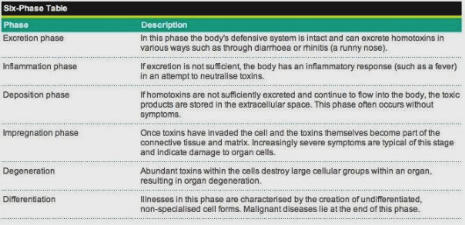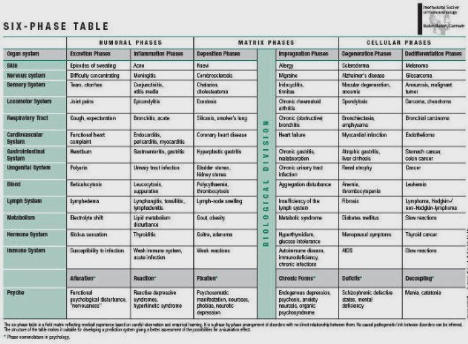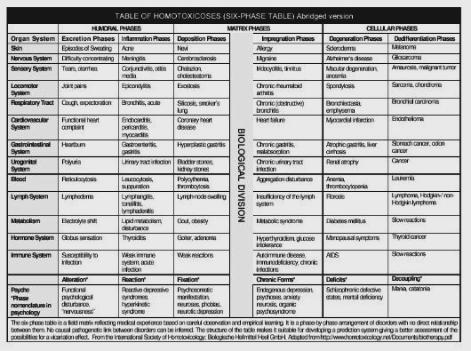


Homotoxicology
was
founded
in
1952
from
Dr
Reckeweg
as
an
extension
of
classic
Homeopathy.
The
word
'Homotoxine'
means
'human
poison' or 'human toxic substance'- from the Latin word homo=man and the Greek word tokson =poison.
Dr
Reckeweg
started
with
the
principles
of
classical
Homoeopathy
as
developed
by
Hahnemann,
and
integrated
them
with
the
new
discoveries
in
biochemistry
and
embryology
that
had
been
made
by
the
1940's.
He
defined
'Homotoxins'
as
substances
that
were
harmful
to the human body.
'Homotoxones' are substances within the body that bind with and neutralise homotoxins, preparing them for elimination from the body.
Today
Homotoxicology
is
seen
as
a
bridge
between
Homeopathy
and
conventional
Medicine.
In
Homotoxicology,
it
is
understood
that
diseases
are
caused
by
toxins.
These
toxins
are
seen
to
originate
either
outside
the
body
(exotoxins)
or
within
the
body
(endotoxins).
Examples
of
exotoxins
are
bacteria,
metals
such
as
mercury,
micro-organisms
in
the
gut
causing
dysbiosis
(often
due
to
an
unhealthy
diet,
hormone
replacement
therapy,
and
antibiotics),
chronic
yeast
infections
(Candida),
chemical
pollutants
such
as
gas,
diesel
and
petrol
fumes
,
exposure
to
unhealthy
electro-magnetic
fields,
pesticides,
and
undiagnosed
bacterial
(salmonella
paratyphi),
or
protozoon
(Giardia
and
amoeba) infections in the gut. Endotoxins are biologically derived, or result from post-traumatic cellular debris.
They are generated by the body.
Homotoxicology
sees
disease
as
the
result
of
the
body's
attempt
to
heal
itself.
Toxins
are
either
created
in
the
human
organism
or
are
exogenous,
and
all
the
symptoms
of
illness
are
the
result
of
defensive
effort
of
organism
in
order
to
eliminate
the
toxins.
In
other
words,
in
Homotoxicology,
virtually
all
symptoms
of
illness
are
regarded
as
a
manifestation
of
the
body's
attempts
to
rid
itself
of
Homotoxins.
In
minor,
self-limiting
disorders,
the
body
does
this
unaided.
In
more
serious
situations,
treatment
is
needed.
If
the
treatment
used
eliminates
the
Homotoxins,
then
real
healing
results
and
Dr.
Reckeweg
called
this
phenomenon
'regressive
vicariation.'
If
the
treatment
suppresses
the
Homotoxins,
however,
(antibiotics,
steroids;
most
drugs)
then
they
go
deeper
into
the
tissues
and
manifest
after
a
latent
period
as
a
more
destructive
disease.
This
is
called
'progressive
vicariation',
and
may
lead
to
chronic
degenerative
disease
and,
ultimately,
to cancer.
In
general,
Homotoxicological
products
are
designed
to
facilitate
the
body's
elimination
of
toxins.
They
do
not
suppress
symptoms.
Homotoxicology
is
a
system
of
medicine
that
aims
to
induce
regulation.
It
is
known
as
'regulation
therapy'.
Homotoxicology
generally
uses
formulations,
which
contain
measurable
amounts
of
Homeopathically
prepared
active
ingredients
and
are
used
to
treat
specific
indications.
They
are
often
presented
to
the
body
in
the
same
dilution
ratio
as
inter
cellular
fluids.
Homotoxic
treatment
has
been
used
successfully in chronic diseases, inflammatory conditions, Rheumatoid Arthritis, Allergies and Food intolerances.
Dr
Reckeweg
developed
a
range
of
complex
homoeopathic
medicines
to
enhance
homotoxone
production
and
resolve
symptoms
by
eliminating
toxins.
These
medicines
also
activate
what
Reckeweg
called
the
'greater
defence
system',
a
concerted
neurological,
endocrine,
immunological,
metabolic
and
connective
tissue
response
that
gives
rise
to
symptoms
but
has
an
enormous
capacity
to
neutralize
and
excrete Homotoxins.
Homotoxicology acts through:
Shaping of antibodies.
Defensive mechanism of hypophysis and suprarenal glands.
Sympathetic system and the regulation of defence against the poisons.
Detoxification of liver.
Elimination of toxins from endogenous and exogenous sources.
References
Bianchi, I. (2000). Geriatría y homotoxicología. Baden-Baden (Alemania): Aurelia-Verlag
Claussen,
C.F.
(1997).
Homotoxicología.
El
núcleo
de
un
planteamiento
holístico
y
probiótico
de
la
medicina.
Baden-Baden
(Alemania):
Aurelia-Verlag GmbH.
Heine,
H.
(2000).
Homotoxicología.
Una
síntesis
de
las
orientaciones
médicas
basadas
en
las
ciencias
naturales.
Baden-Baden
(Alemania): Aurelia-Verlag GmbH.
Küstermann, K. (2000). Enfermedades reumáticas y su terapia antihomotóxica. Baden-Baden (Alemania): Aurelia-Verlag GmbH.
Pischinger,
A.
(2007).
The
Extracellular
Matrix
and
Ground
Regulation:
Basis
for
a
Holistic
Biological
Medicine.
California
(USA):
North
Atlantic Books.
Reckeweg,
H.H.
(1992).
Homotoxicología.
Enfermedad
y
curación
con
terapias
antihomotóxicas.
Baden-Baden
(Alemania):
Aurelia-
Verlag GmbH.
Rosales,
M.
(2005).
Síndrome
de
inflamación
de
las
mucosas.
Tratamiento
antihomotóxico
(2ª
ed).
Colombia:
Panamericana
formas
e
Impresos S.A.
Schmid,
F.;
Rimpler,
M.;
Wemmer,
U.
(1997).
Medicina
antihomotóxica
Vol.
1:
principios,
clínica
práctica.
Baden-Baden
(Alemania):
Aurelia-Verlag GmbH.
Smit,
A.;
O’Byrne,
A.
Van
Brandt,
B.;
Bianchi,
I.;
Kuestermann,
K.
(2009).
Introduction
to
Bioregulatory
Medicine.
Stuttgart
(Alemania):
Georg Thieme Verlag
Sociedad
Internacional
de
Homotoxicología.
(2007).
Ordinatio
Antihomotoxica
et
Materia
Medica
(9ª
ed).
Baden-Baden
(Alemania):
Aurelia-Verlag GMBH
Smit, A. (2004). Detoxificación y drenaje. Medicina biológica 1 (17):19-27.
Smit, A. (2006). Homotoxicología y sistema digestivo. Medicina biológica 1 (19):24-32.
Tabla de las Homotoxicosis (Tabla de las Seis Fases), Lab. Heel.
If you would like additional information regarding our services or to request an appointment, you can contact us by phone
(952 80 53 68) or by email.




















© 2023 - Centro Medicina Natural y Antienvejecimiento - Neural therapy, Homeopathy, Ozone therapy, Carboxytherapy, Mesotherapy
Avda. Juan Carlos I, nº 29, portal 5, 2ºB -- 29680, Estepona (Málaga)
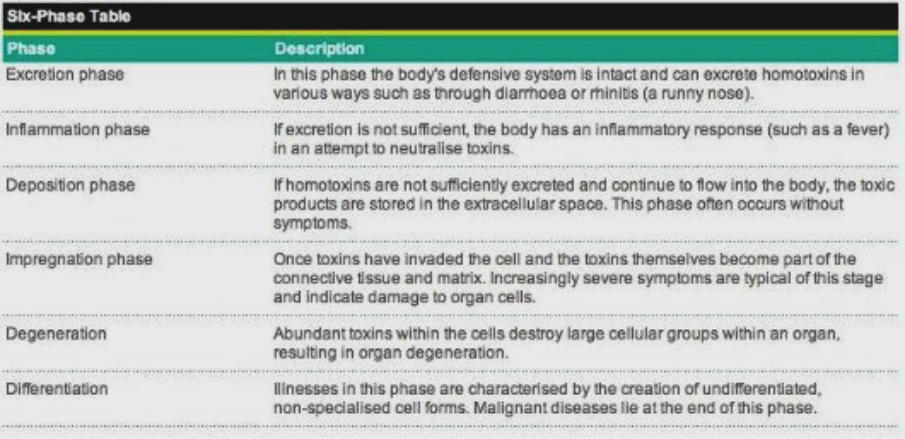
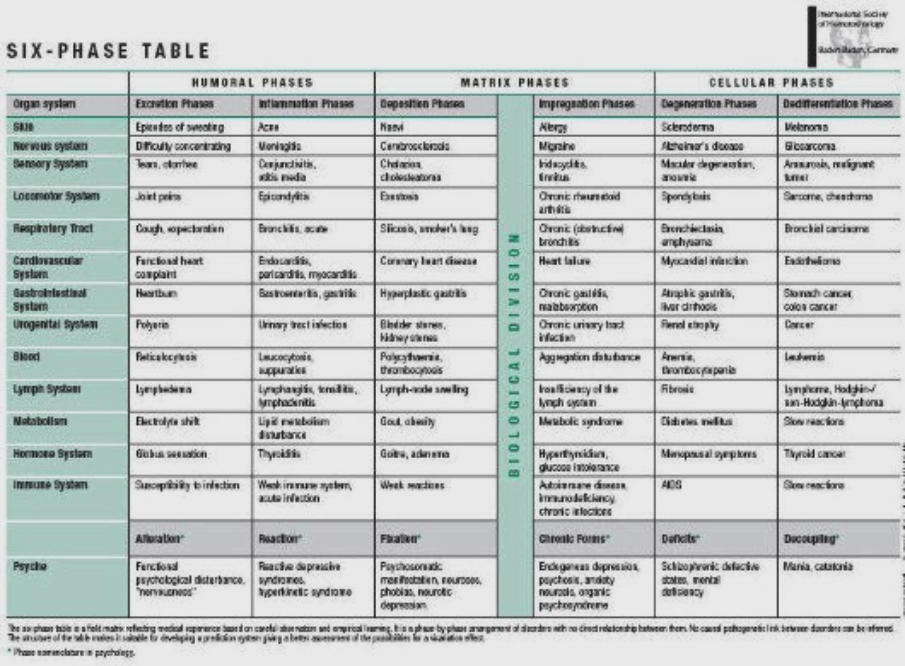
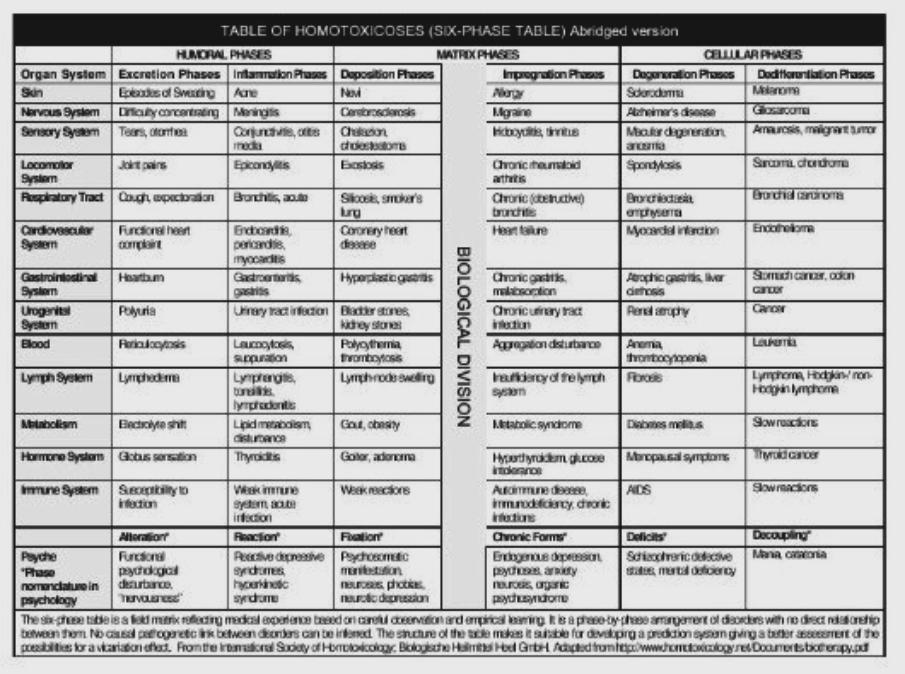

© 2023 - Centro Medicina Natural y Antienvejecimiento
Tel: 952 80 53 68
E-mail: info@medicinabiologica.es
Homotoxicology
Homotoxicology
was
founded
in
1952
from
Dr
Reckeweg
as
an
extension
of
classic
Homeopathy.
The
word
'Homotoxine'
means
'human
poison'
or
'human
toxic
substance'-
from
the
Latin
word
homo=man and the Greek word tokson =poison.
Dr
Reckeweg
started
with
the
principles
of
classical
Homoeopathy
as
developed
by
Hahnemann,
and
integrated
them
with
the
new
discoveries
in
biochemistry
and
embryology
that
had
been
made
by
the
1940's.
He
defined
'Homotoxins'
as
substances
that
were
harmful
to the human body.
'Homotoxones'
are
substances
within
the
body
that
bind
with
and
neutralise
homotoxins,
preparing
them
for
elimination
from
the
body.
Today
Homotoxicology
is
seen
as
a
bridge
between
Homeopathy
and
conventional
Medicine.
In
Homotoxicology,
it
is
understood
that
diseases
are
caused
by
toxins.
These
toxins
are
seen
to
originate
either
outside
the
body
(exotoxins)
or
within
the
body
(endotoxins).
Examples
of
exotoxins
are
bacteria,
metals
such
as
mercury,
micro-
organisms
in
the
gut
causing
dysbiosis
(often
due
to
an
unhealthy
diet,
hormone
replacement
therapy,
and
antibiotics),
chronic
yeast
infections
(Candida),
chemical
pollutants
such
as
gas,
diesel
and
petrol
fumes
,
exposure
to
unhealthy
electro-magnetic
fields,
pesticides,
and
undiagnosed
bacterial
(salmonella
paratyphi),
or
protozoon
(Giardia
and
amoeba)
infections
in
the
gut.
Endotoxins
are
biologically derived, or result from post-traumatic cellular debris.
They are generated by the body.
Homotoxicology
sees
disease
as
the
result
of
the
body's
attempt
to
heal
itself.
Toxins
are
either
created
in
the
human
organism
or
are
exogenous,
and
all
the
symptoms
of
illness
are
the
result
of
defensive
effort
of
organism
in
order
to
eliminate
the
toxins.
In
other
words,
in
Homotoxicology,
virtually
all
symptoms
of
illness
are
regarded
as
a
manifestation
of
the
body's
attempts
to
rid
itself
of
Homotoxins.
In
minor,
self-limiting
disorders,
the
body
does
this
unaided.
In
more
serious
situations,
treatment
is
needed.
If
the
treatment
used
eliminates
the
Homotoxins,
then
real
healing
results
and
Dr.
Reckeweg
called
this
phenomenon
'regressive
vicariation.'
If
the
treatment
suppresses
the
Homotoxins,
however,
(antibiotics,
steroids;
most
drugs)
then
they
go
deeper
into
the
tissues
and
manifest
after
a
latent
period
as
a
more
destructive
disease.
This
is
called
'progressive
vicariation',
and
may
lead
to
chronic
degenerative
disease and, ultimately, to cancer.
In
general,
Homotoxicological
products
are
designed
to
facilitate
the
body's
elimination
of
toxins.
They
do
not
suppress
symptoms.
Homotoxicology
is
a
system
of
medicine
that
aims
to
induce
regulation.
It
is
known
as
'regulation
therapy'.
Homotoxicology
generally
uses
formulations,
which
contain
measurable
amounts
of
Homeopathically
prepared
active
ingredients
and
are
used
to
treat
specific
indications.
They
are
often
presented
to
the
body
in
the
same
dilution
ratio
as
inter
cellular
fluids.
Homotoxic
treatment
has
been
used
successfully
in
chronic
diseases,
inflammatory
conditions,
Rheumatoid Arthritis, Allergies and Food intolerances.
Dr
Reckeweg
developed
a
range
of
complex
homoeopathic
medicines
to
enhance
homotoxone
production
and
resolve
symptoms
by
eliminating
toxins.
These
medicines
also
activate
what
Reckeweg
called
the
'greater
defence
system',
a
concerted
neurological,
endocrine,
immunological,
metabolic
and
connective
tissue
response
that
gives
rise
to
symptoms
but
has
an
enormous
capacity
to
neutralize and excrete Homotoxins.
Homotoxicology acts through:
Shaping of antibodies.
Defensive mechanism of hypophysis and suprarenal glands.
Sympathetic
system
and
the
regulation
of
defence
against
the
poisons.
Detoxification of liver.
Elimination of toxins from endogenous and exogenous sources.
References
Bianchi,
I.
(2000).
Geriatría
y
homotoxicología.
Baden-Baden
(Alemania): Aurelia-Verlag
Claussen,
C.F.
(1997).
Homotoxicología.
El
núcleo
de
un
planteamiento
holístico
y
probiótico
de
la
medicina.
Baden-Baden
(Alemania): Aurelia-Verlag GmbH.
Heine,
H.
(2000).
Homotoxicología.
Una
síntesis
de
las
orientaciones
médicas
basadas
en
las
ciencias
naturales.
Baden-
Baden (Alemania): Aurelia-Verlag GmbH.
Küstermann,
K.
(2000).
Enfermedades
reumáticas
y
su
terapia
antihomotóxica. Baden-Baden (Alemania): Aurelia-Verlag GmbH.
Pischinger,
A.
(2007).
The
Extracellular
Matrix
and
Ground
Regulation:
Basis
for
a
Holistic
Biological
Medicine.
California
(USA):
North Atlantic Books.
Reckeweg,
H.H.
(1992).
Homotoxicología.
Enfermedad
y
curación
con
terapias
antihomotóxicas.
Baden-Baden
(Alemania):
Aurelia-Verlag GmbH.
Rosales,
M.
(2005).
Síndrome
de
inflamación
de
las
mucosas.
Tratamiento
antihomotóxico
(2ª
ed).
Colombia:
Panamericana
formas
e Impresos S.A.
Schmid,
F.;
Rimpler,
M.;
Wemmer,
U.
(1997).
Medicina
antihomotóxica
Vol.
1:
principios,
clínica
práctica.
Baden-Baden
(Alemania): Aurelia-Verlag GmbH.
Smit,
A.;
O’Byrne,
A.
Van
Brandt,
B.;
Bianchi,
I.;
Kuestermann,
K.
(2009).
Introduction
to
Bioregulatory
Medicine.
Stuttgart
(Alemania):
Georg Thieme Verlag
Sociedad
Internacional
de
Homotoxicología.
(2007).
Ordinatio
Antihomotoxica
et
Materia
Medica
(9ª
ed).
Baden-Baden
(Alemania):
Aurelia-Verlag GMBH
Smit,
A.
(2004).
Detoxificación
y
drenaje.
Medicina
biológica
1
(17):19-27.
Smit,
A.
(2006).
Homotoxicología
y
sistema
digestivo.
Medicina
biológica 1 (19):24-32.
Tabla de las Homotoxicosis (Tabla de las Seis Fases), Lab. Heel.
If you would like additional information regarding our services
or to request an appointment, you can contact us by phone
(952 80 53 68) or by email.



















